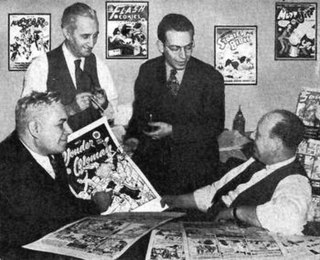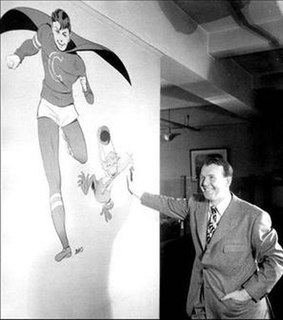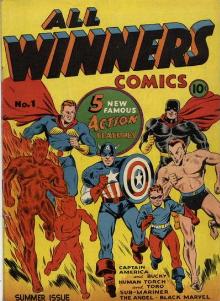
The Silver Age of Comic Books was a period of artistic advancement and widespread commercial success in mainstream American comic books, predominantly those featuring the superhero archetype. Following the Golden Age of Comic Books and an interregnum in the early to mid-1950s, the Silver Age is considered to cover the period from 1956 to the end of 1969, and was succeeded by the Bronze Age.

Maxwell Charles Gaines was a pioneering figure in the creation of the modern comic book.

Timely Comics is the common name for the group of corporations that was the earliest comic book arm of American publisher Martin Goodman, and the entity that would evolve by the 1960s to become Marvel Comics.

An American comic book is a thin book, averaging 32 pages and containing a series of images and words known as comics. While the form originated in 1933, American comic books first gained popularity after the 1938 publication of Action Comics, which included the debut of the superhero Superman. This was followed by a superhero boom that lasted until the end of World War II. After the war, until superheroes were marginalized, the comic book industry rapidly expanded and genres such as horror, crime, science fiction and romance became popular. The 1950s saw a gradual decline, due to a shift away from print media in the wake of television and the impact of the Comics Code Authority. The late 1950s and the 1960s saw a superhero revival and superheroes remained the dominant character archetype throughout the late 20th century into the 21st century.

Fawcett Comics, a division of Fawcett Publications, was one of several successful comic book publishers during the Golden Age of Comic Books in the 1940s. Its most popular character was Captain Marvel, the alter ego of radio reporter Billy Batson, who transformed into the hero whenever he said the magic word "Shazam!".

Charles Biro was an American comic book creator and cartoonist. He is today chiefly known for creating the comic book characters Airboy and Steel Sterling, and for his work at Lev Gleason Publications on Daredevil Comics and Crime Does Not Pay.

The Funnies was the name of two American publications from Dell Publishing, the first of these a seminal 1920s precursor of comic books, and the second a standard 1930s comic book.

More Fun Comics, originally titled New Fun: The Big Comic Magazine a.k.a. New Fun Comics, was a 1935–1947 American comic book anthology that introduced several major superhero characters and was the first American comic book series to feature solely original material rather than reprints of newspaper comic strips. It was also the first publication of the company that would become DC Comics.

Atlas Comics is the 1950s comic-book publishing label that evolved into Marvel Comics. Magazine and paperback novel publisher Martin Goodman, whose business strategy involved having a multitude of corporate entities, used Atlas as the umbrella name for his comic-book division during this time. Atlas evolved out of Goodman's 1940s comic-book division, Timely Comics, and was located on the 14th floor of the Empire State Building. This company is distinct from the 1970s comic-book company, also founded by Goodman, that is known as Atlas/Seaboard Comics.

Crestwood Publications, also known as Feature Publications, was a magazine publisher that also published comic books from the 1940s through the 1960s. Its title Prize Comics contained what is considered the first ongoing horror comic-book feature, Dick Briefer's "Frankenstein". Crestwood is best known for its Prize Group imprint, published in the late 1940s to mid-1950s through packagers Joe Simon and Jack Kirby, who created such historically prominent titles as the horror comic Black Magic, the creator-owned superhero satire Fighting American, and the first romance comic title, Young Romance.
Anthony Louis "Tony" DiPreta was an American comic book and comic strip artist active from the 1940s Golden Age of comic books. He was the longtime successor artist of the comic strip Joe Palooka (1959–84) and drew the Rex Morgan, M.D. daily strip from 1983 until DiPreta's retirement in 2000.

Blue Ribbon Comics is the name of two American comic book anthology series, the first published by the Archie Comics predecessor MLJ Magazines Inc., commonly known as MLJ Comics, from 1939 to 1942, during the Golden Age of Comic Books. The revival was the second comic published in the 1980s by Archie Comics under the Red Circle and Archie Adventure Series banners.

All Winners Comics was the name of two American comic book series of the 1940s, both published by Marvel Comics' predecessor, Timely Comics, during the period fans and historians call the Golden Age of Comic Books. A superhero anthology comic in both cases, they variously featured such star characters as Captain America, the original Human Torch, and the Sub-Mariner. All Winners Comics was also the venue for two full-length stories of Marvel's first superhero team, the (hyphenated) All-Winners Squad.

Police Comics was a comic book anthology title published by Quality Comics from 1941 until 1953. It featured short stories in the superhero, crime and humor genres.

Romance comics is a comics genre depicting strong and close romantic love and its attendant complications such as jealousy, marriage, divorce, betrayal, and heartache. The term is generally associated with an American comic books genre published through the first three decades of the Cold War (1947–1977). Romance comics of the period typically featured dramatic scripts about the love lives of older high school teens and young adults, with accompanying artwork depicting an urban or rural America contemporaneous with publication.
Hillman Periodicals, Inc., was an American magazine and comic book publishing company founded in 1938 by Alex L. Hillman, a former New York City book publisher. It is best known for its true confession and true crime magazines; for the long-running general-interest magazine Pageant; and for comic books including Air Fighters Comics and its successor Airboy Comics, which launched the popular characters Airboy and The Heap.

Crime comics is a genre of American comic books and format of crime fiction. The genre was originally popular in the late 1940s and early 1950s and is marked by a moralistic editorial tone and graphic depictions of violence and criminal activity. Crime comics began in 1942 with the publication of Crime Does Not Pay published by Lev Gleason Publications and edited by Charles Biro. As sales for superhero comic books declined in the years after World War II, other publishers began to emulate the popular format, content and subject matter of Crime Does Not Pay, leading to a deluge of crime-themed comics. Crime and horror comics, especially those published by EC Comics, came under official scrutiny in the late 1940s and early 1950s, leading to legislation in Canada and Great Britain, the creation in the United States of the Comics Magazine Association of America and the imposition of the Comics Code Authority in 1954. This code placed limits on the degree and kind of criminal activity that could be depicted in American comic books, effectively sounding the death knell for crime comics and their adult themes.

Famous Funnies is an American comic strip anthology series published from 1934 to 1955. Published by Eastern Color Printing, Famous Funnies is considered by popular culture historians as the first true American comic book, following seminal precursors.

Young Romance is a romantic comic book series created by Joe Simon and Jack Kirby for the Crestwood Publications imprint Prize Comics in 1947. Generally considered the first romance comic, the series ran for 124 consecutive issues under Prize imprint, and a further 84 published by DC Comics after Crestwood stopped producing comics.
Toby Press was an American comic-book company that published from 1949 to 1955. Founded by Elliott Caplin, brother of cartoonist Al Capp and himself an established comic strip writer, the company published reprints of Capp's Li'l Abner strip; licensed-character comics starring such film and animated cartoon properties as John Wayne and Felix the Cat; and original conceptions, including romance, war, Western, and adventure comics. Some of its comics were published under the imprint Minoan. Some covers bore the logo ANC, standing for American News Company, at the time the country's largest newsstand distributor.















